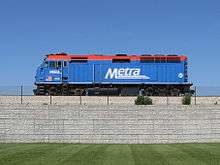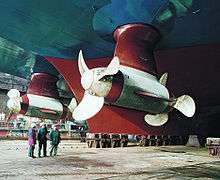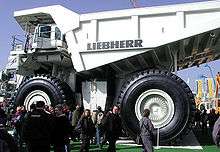Diesel-electric transmission

Diesel-electric transmission, or diesel-electric powertrain is used by a number of vehicle and ship types for providing locomotion.
A diesel-electric transmission system includes a diesel engine connected to an electrical generator, creating electricity that powers electric traction motors. No clutch is required. Before diesel engines came into widespread use, a similar system, using a petrol (gasoline) engine and called petrol-electric or gas-electric, was sometimes used.
Diesel-electric transmission is used on railways by diesel electric locomotives and diesel electric multiple units, as electric motors are able to supply full torque at 0 RPM. Diesel-electric systems are also used in submarines and surface ships and some land vehicles.
In some high-efficiency applications, electrical energy may be stored in rechargeable batteries, in which case these vehicles can be considered as a class of hybrid electric vehicle.
Ships

The first diesel motorship was also the first diesel-electric ship, the Russian tanker Vandal from Branobel, which was launched in 1903. Steam turbine-electric propulsion has been in use since the 1920s (Tennessee-class battleships), using diesel-electric powerplants in surface ships has increased lately. The Finnish coastal defence ships Ilmarinen and Väinämöinen laid down in 1928–1929, were among the first surface ships to use diesel-electric transmission. Later, the technology was used in diesel powered icebreakers.
In World War II the United States built diesel-electric surface warships. Due to machinery shortages destroyer escorts of the Evarts and Cannon classes were diesel-electric, with half their designed horsepower (The Buckley and Rudderow classes were full-power steam turbine-electric).[1] The Wind-class icebreakers, on the other hand, were designed for diesel-electric propulsion because of its flexibility and resistance to damage.[2][3]
Some modern diesel-electric ships, including cruise ships and icebreakers, use electric motors in pods called azimuth thrusters underneath to allow for 360° rotation, making the ships far more maneuverable. An example of this is the Harmony of the Seas, the largest passenger ship as of 2016.
Gas turbines are also used for electrical power generation and some ships use a combination: the Queen Mary 2 has a set of diesel engines in the bottom of the ship plus two gas turbines mounted near the main funnel; all are used for generating electrical power, including those used to drive the propellers. This provides a relatively simple way to use the high-speed, low-torque output of a turbine to drive a low-speed propeller, without the need for excessive reduction gearing.
Submarines
Early submarines used a direct mechanical connection between the engine and propeller, switching between diesel engines for surface running, and electric motors for submerged propulsion. This was effectively a "parallel" type of hybrid, since the motor and engine were coupled to the same shaft. On the surface, the motor (driven by the engine) was used as a generator to recharge the batteries and supply other electric loads. The engine would be disconnected for submerged operation, with batteries powering the electric motor and supplying all other power as well.
True diesel-electric transmissions for submarines were first proposed by the United States Navy's Bureau of Engineering in 1928; instead of driving the propeller directly while running on the surface, the submarine's diesel would instead drive a generator that could either charge the submarine's batteries or drive the electric motor. This meant that motor speed was independent of the diesel engine's speed, and the diesel could run at an optimum and non-critical speed, while one or more of the diesel engines could be shut down for maintenance while the submarine continued to run using battery power. The concept was pioneered in 1929 in the S-class submarines S-3, S-6, and S-7 to test the concept. The first production submarines with this system were the Porpoise-class, and it was used on most subsequent US diesel submarines through the 1960s. The only other navy to adopt the system before 1945 was the British Royal Navy in the U-class submarines, although some submarines of the Imperial Japanese Navy used separate diesel generators for low-speed running.[4]
In a diesel-electric transmission arrangement, as used on 1930s and later US Navy, German, Russian and other nations' diesel submarines, the propellers are driven directly or through reduction gears by an electric motor, while two or more diesel generators provide electric energy for charging the batteries and/or driving the electric motors. This mechanically isolates the noisy engine compartment from the outer pressure hull and reduces the acoustic signature of the submarine when surfaced. Some nuclear submarines also use a similar turbo-electric propulsion system, with propulsion turbo generators driven by reactor plant steam.
Railway engines
During World War I, there was a strategic need for rail engines without plumes of smoke above them. Diesel technology was not yet sufficiently developed but a few precursor attempts were made, especially for petrol-electric transmissions by the French (Crochat-Collardeau, patent dated 1912 also used for tanks and trucks) and British (Dick, Kerr & Co. and British Westinghouse). About 300 of these locomotives, only 96 being standard gauge, were in use at various points in the conflict. Even before the war, the GE 57-ton gas-electric boxcab had been produced in the USA.
In the 1920s, diesel-electric technology first saw limited use in switchers (or shunters), locomotives used for moving trains around in railroad yards and assembling and disassembling them. An early company offering "Oil-Electric" locomotives was the American Locomotive Company (ALCO). The ALCO HH series of diesel-electric switcher entered series production in 1931. In the 1930s, the system was adapted for streamliners, the fastest trains of their day. Diesel-electric powerplants became popular because they greatly simplified the way motive power was transmitted to the wheels and because they were both more efficient and had greatly reduced maintenance requirements. Direct-drive transmissions can become very complex, considering that a typical locomotive has four or more axles. Additionally, a direct-drive diesel locomotive would require an impractical number of gears to keep the engine within its powerband; coupling the diesel to a generator eliminates this problem. An alternative is to use a torque converter or fluid coupling in a direct drive system to replace the gearbox. Hydraulic transmissions are claimed to be somewhat more efficient than diesel-electric technology.[5]
Road and other land vehicles
Trucks

Examples include:
- Large mining machines, such as the Liebherr T 282B dump truck or LeTourneau L-2350 wheel loader.
- NASA's huge Crawler-Transporters.
- Mitsubishi Fuso Canter Eco Hybrid commercial truck.
- International DuraStar Hybrid diesel-electric truck.[6]
- Dodge is conducting fleet tests of a diesel-electric version of the Dodge Sprinter.[7][8]
Concepts
In the automobile industry, diesel engines in combination with electric transmissions and battery power are being developed for future vehicle drive systems. Partnership for a New Generation of Vehicles was a cooperative research program between the U.S. government and "The Big Three" automobile manufacturers (DaimlerChrysler, Ford Motor Company, and General Motors Corporation) that developed diesel hybrid cars.
- "Third-Millennium Cruiser", an attempt to commercialize a diesel-electric automobile in the very early 1980s.
- General Motors Precept
- Ford Prodigy
- Dodge Intrepid ESX
- Ford Reflex is a diesel hybrid concept car.[9]
- Zytek develops a diesel hybrid powertrain[10][11]
- Citroën C-Cactus[12]
- Chevrolet Volt/Opel Flextreme
- Top Gear Hammerhead-i Eagle Thrust
- Rivian Automotive is developing a diesel-electric engine that should achieve an estimated 90 miles per gallon in the city and over 100 miles per gallon on the highway[13]
Production-ready cars
- Volkswagen Golf TDI Hybrid[14]
- Mercedes-Benz E-Class E300 BlueTEC hybrid
- Mercedes-Benz S-Class S300 BlueTEC hybrid
- Peugeot 3008 Crossover with HYbrid4 technology
- Peugeot 508 RXH with HYbrid4 technology
- Volvo V60 plug-in diesel hybrid[15]
- Citroën DS5 with Hybrid4 drive[16]
- DS 5 with HYbrid4 drive
Military vehicles
Diesel-electric propulsion has been tried on some military vehicles, such as tanks. The prototype TOG1 and TOG2 super heavy tanks of the second world war used twin generators driven by V12 diesel engines. More recent prototypes include the SEP modular armoured vehicle and T95e. Future tanks may use diesel-electric drives to improve fuel efficiency while reducing the size, weight and noise of the power plant.[17] Attempts with diesel-electric drives on wheeled military vehicles include the unsuccessful ACEC Cobra, MGV and XM1219 Armed Robotic Vehicle.
Buses


Diesel electric based buses have also been produced, including hybrid systems able to run on and store electrical power in batteries. The two main providers of hybrid systems for diesel-electric transit buses include Allison Transmission and BAE Systems. New Flyer Industries, Gillig Corporation, and North American Bus Industries are major customers for the Allison EP hybrid systems, while Orion Bus Industries is a major customer for the BAE HybriDrive system. Mercedes-Benz makes their own diesel-electric drive system, which is used in their Cito.
See also
References
- ↑ Silverstone, Paul H (1966). U.S. Warships of World War II. Doubleday and Company. pp. 153–167.
- ↑ Silverstone(66), page378
- ↑ "USCG Icebreakers". U.S. Coast Guard Cutter History. United States Coast Guard. Retrieved 2012-12-12.
- ↑ Friedman, Norman (1995). U.S. submarines through 1945: an illustrated design history. Naval Institute Press. pp. 259–260. ISBN 1557502633.
- ↑
- ↑ International starts hybrid production - eTrucker
- ↑ Dodge Sprinter Plug-in Hybrid Electric Vehicle (PHEV)
- ↑ Dodge - 2007 Sprinter - Passenger Vans, Cargo Vans
- ↑ Diesel hybrid car also taps the sun - Green Machines - MSNBC.com
- ↑ World’s first affordable diesel hybrid powertrain
- ↑ UK Company Zytek develops Affordable Ultra Efficient Diesel Hybrid System
- ↑ Frankfurt Green: Citroen C-Cactus - The Car Connection
- ↑ "Rivian Automotive - Waves of Change". Automoblog. 11 August 2011. Retrieved 11 August 2011.
- ↑ Geneva 2008: Volkswagen Golf TDI Hybrid
- ↑ Volvo's production-ready V60 Plug-in Diesel Hybrid
- ↑ http://www.ds5.citroen.com/
- ↑ "Electric/Hybrid Electric Drive Vehicles for Military Applications", Military Technology (Moench Verlagsgesellschaft mbH) (9/2007): 132–144, September 2007, pp. 132–144
External links
- How Diesel-fueled Hybrids Work at HowStuffWorks
- EERE Clean Fleet Guide by vehicle type
- Hybrid-Vehicle.org: Information on hybrid vehicle history, technology and practical application in a broad spectrum of vehicles
- Diesel Hybrid News